Financial Analysis of British Airways: Evaluating Performance and Risk Factors
VerifiedAdded on 2023/01/17
|15
|3652
|100
AI Summary
This report provides a comprehensive financial analysis of British Airways, including evaluating its performance through ratios and identifying risk factors that affect its brand reputation and market position.
Contribute Materials
Your contribution can guide someone’s learning journey. Share your
documents today.

Business Bus
Secure Best Marks with AI Grader
Need help grading? Try our AI Grader for instant feedback on your assignments.
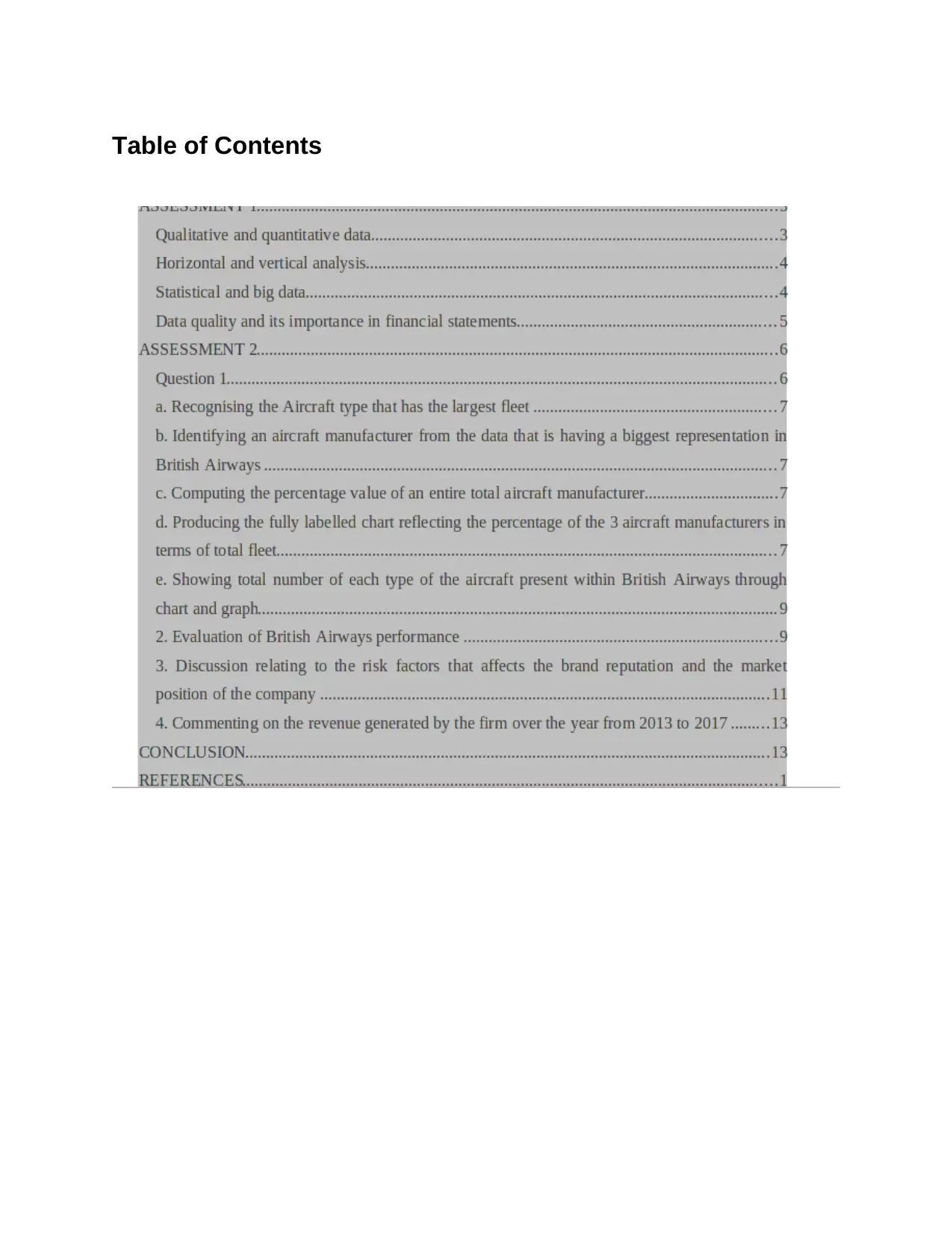
Table of Contents

INTRODUCTION
Financial analysis is the practice of evaluating the processes, projects, budgets and the
other financial related transactions for determining the suitability and the performance of the
business. Specifically, financial analysis is been used for assessing that an entity is solvent,
profitable, liquid and stable in warranting its monetary investment. Application of the statistical
tools such as median and mean helps in knowing the average value of the revenues over the
years and in interpreting the growing level of the revenues over the period. The present report is
based on British Airways, operating as the second leading Airline company in United Kingdom
on the basis of fleet size and in carrying the passengers. Furthermore. The study throws deeper
insights into the horizontal and the vertical analysis with showing an evaluation of the
performance by applying ratio analysis. Moreover the report states various risk factors that
affects market position and the revenue of the company.
ASSESSMENT 1
Qualitative and quantitative data
The data can be collected in numerical terms or in terms of facts and theoretical data i.e.
in quantitative or qualitative manner (Holton and Walsh, 2016). Both kinds of data have separate
characteristics and therefore, can be differentiated on the basis of certain points.
Qualitative Data Quantitative Data
This kind of data is used to describe
qualities of the intended object or its
characteristics and is usually
collected form methods such as
interviews or questionnaires and can
be descriptive in nature. It is
generally interpreted and analysed by
categorising the facts that have been
collected in a thematic manner and
then subsequently, conclusions are
drawn accordingly in the
The data collected is in quantifiable
or measurable terms and addresses
the how many or what aspect of a
particular problem. Such data is also
gathered using different instruments
such as rating scales or questionnaires
and in order to analyse or interpret the
data, tools like SPSS, Statistical
analysis software etc. are used so that
the conclusions can also be drawn in
quantifiable terms.
Financial analysis is the practice of evaluating the processes, projects, budgets and the
other financial related transactions for determining the suitability and the performance of the
business. Specifically, financial analysis is been used for assessing that an entity is solvent,
profitable, liquid and stable in warranting its monetary investment. Application of the statistical
tools such as median and mean helps in knowing the average value of the revenues over the
years and in interpreting the growing level of the revenues over the period. The present report is
based on British Airways, operating as the second leading Airline company in United Kingdom
on the basis of fleet size and in carrying the passengers. Furthermore. The study throws deeper
insights into the horizontal and the vertical analysis with showing an evaluation of the
performance by applying ratio analysis. Moreover the report states various risk factors that
affects market position and the revenue of the company.
ASSESSMENT 1
Qualitative and quantitative data
The data can be collected in numerical terms or in terms of facts and theoretical data i.e.
in quantitative or qualitative manner (Holton and Walsh, 2016). Both kinds of data have separate
characteristics and therefore, can be differentiated on the basis of certain points.
Qualitative Data Quantitative Data
This kind of data is used to describe
qualities of the intended object or its
characteristics and is usually
collected form methods such as
interviews or questionnaires and can
be descriptive in nature. It is
generally interpreted and analysed by
categorising the facts that have been
collected in a thematic manner and
then subsequently, conclusions are
drawn accordingly in the
The data collected is in quantifiable
or measurable terms and addresses
the how many or what aspect of a
particular problem. Such data is also
gathered using different instruments
such as rating scales or questionnaires
and in order to analyse or interpret the
data, tools like SPSS, Statistical
analysis software etc. are used so that
the conclusions can also be drawn in
quantifiable terms.
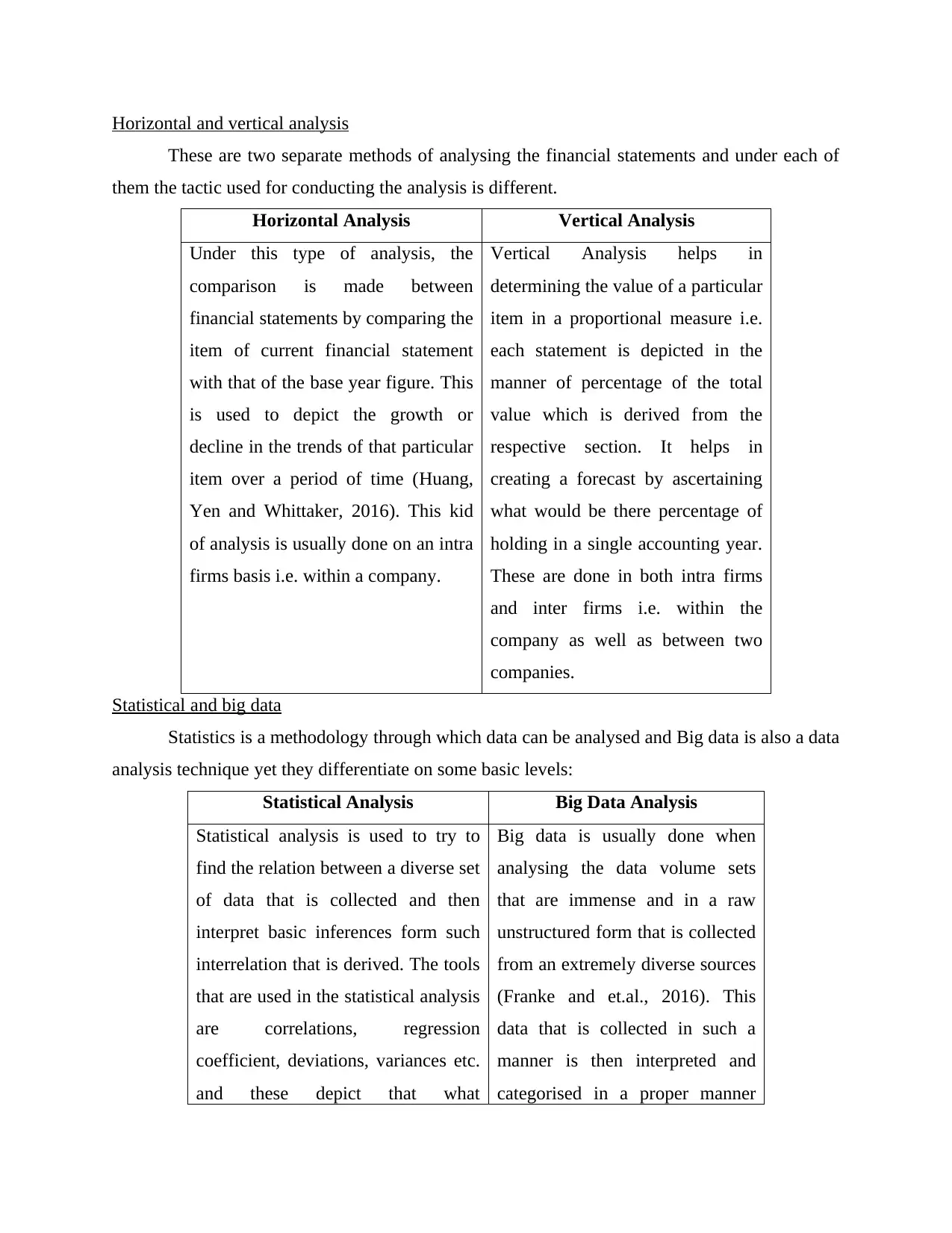
Horizontal and vertical analysis
These are two separate methods of analysing the financial statements and under each of
them the tactic used for conducting the analysis is different.
Horizontal Analysis Vertical Analysis
Under this type of analysis, the
comparison is made between
financial statements by comparing the
item of current financial statement
with that of the base year figure. This
is used to depict the growth or
decline in the trends of that particular
item over a period of time (Huang,
Yen and Whittaker, 2016). This kid
of analysis is usually done on an intra
firms basis i.e. within a company.
Vertical Analysis helps in
determining the value of a particular
item in a proportional measure i.e.
each statement is depicted in the
manner of percentage of the total
value which is derived from the
respective section. It helps in
creating a forecast by ascertaining
what would be there percentage of
holding in a single accounting year.
These are done in both intra firms
and inter firms i.e. within the
company as well as between two
companies.
Statistical and big data
Statistics is a methodology through which data can be analysed and Big data is also a data
analysis technique yet they differentiate on some basic levels:
Statistical Analysis Big Data Analysis
Statistical analysis is used to try to
find the relation between a diverse set
of data that is collected and then
interpret basic inferences form such
interrelation that is derived. The tools
that are used in the statistical analysis
are correlations, regression
coefficient, deviations, variances etc.
and these depict that what
Big data is usually done when
analysing the data volume sets
that are immense and in a raw
unstructured form that is collected
from an extremely diverse sources
(Franke and et.al., 2016). This
data that is collected in such a
manner is then interpreted and
categorised in a proper manner
These are two separate methods of analysing the financial statements and under each of
them the tactic used for conducting the analysis is different.
Horizontal Analysis Vertical Analysis
Under this type of analysis, the
comparison is made between
financial statements by comparing the
item of current financial statement
with that of the base year figure. This
is used to depict the growth or
decline in the trends of that particular
item over a period of time (Huang,
Yen and Whittaker, 2016). This kid
of analysis is usually done on an intra
firms basis i.e. within a company.
Vertical Analysis helps in
determining the value of a particular
item in a proportional measure i.e.
each statement is depicted in the
manner of percentage of the total
value which is derived from the
respective section. It helps in
creating a forecast by ascertaining
what would be there percentage of
holding in a single accounting year.
These are done in both intra firms
and inter firms i.e. within the
company as well as between two
companies.
Statistical and big data
Statistics is a methodology through which data can be analysed and Big data is also a data
analysis technique yet they differentiate on some basic levels:
Statistical Analysis Big Data Analysis
Statistical analysis is used to try to
find the relation between a diverse set
of data that is collected and then
interpret basic inferences form such
interrelation that is derived. The tools
that are used in the statistical analysis
are correlations, regression
coefficient, deviations, variances etc.
and these depict that what
Big data is usually done when
analysing the data volume sets
that are immense and in a raw
unstructured form that is collected
from an extremely diverse sources
(Franke and et.al., 2016). This
data that is collected in such a
manner is then interpreted and
categorised in a proper manner
Secure Best Marks with AI Grader
Need help grading? Try our AI Grader for instant feedback on your assignments.

relationship exists between two or
more data sets. It is not as vast in
nature as big data and is confined to a
limited number of statistical data.
using different primary keys and
other key fields so that when a
particular word or key field is
entered, amongst a sea of data, the
required data can be collected.
Data quality and its importance in financial statements
Data quality can be defined as the attribute of the data that is collected i.e. the collection
of theoretical or numerical facts and figures that will be used is assembled in a correct and
relevant manner (Cai and Zhu, 2015). When the purpose of intended use for which the data was
collected in the first place is achieved, then such data is termed as a data of higher quality.
Additionally, the consistency of the data that is collected is maintained and the results that are
generated are accurate and precise, then also the quality of data is achieved since it helps in
drawing appropriate conclusions and achieves the purpose for which it was collected. It has a
greater importance while preparing the financial statements as it fulfils several purposes that are
important in maintaining the quality of business:
Data Accuracy: When the organisations are operating at a vast level and there are many
activities that are being performed and many parties with which the company is dealing.
Therefore, it gets difficult and a complex process to collect the data in a relevant manner and this
inconsistency of data might lead to potential loss for the company (Cao, Chychyla and Stewart,
2015). Therefore, when the collection of data is done in a quality manner, i.e. the quality of data
is maintained then this problems gets resolved. This helps the firms in identifying how frequently
what mistakes are being made and what are the recurring faults so that those inaccuracies can be
adequately met and the data quality can be maintained.
Data Completeness: When the recurring faults are removed from the company, then the data
automatically becomes cleansed and improved which further assists in improving the data quality
(Christensen and et.al., 2016). Additionally, theb Use of KPI along with the KRI i.e. Key Risk
Indicators is the key assistance in increasing the data quality and when this will happen, the
accuracy level of the data will automatically rise thus inflicting in the financial statements as
well.
more data sets. It is not as vast in
nature as big data and is confined to a
limited number of statistical data.
using different primary keys and
other key fields so that when a
particular word or key field is
entered, amongst a sea of data, the
required data can be collected.
Data quality and its importance in financial statements
Data quality can be defined as the attribute of the data that is collected i.e. the collection
of theoretical or numerical facts and figures that will be used is assembled in a correct and
relevant manner (Cai and Zhu, 2015). When the purpose of intended use for which the data was
collected in the first place is achieved, then such data is termed as a data of higher quality.
Additionally, the consistency of the data that is collected is maintained and the results that are
generated are accurate and precise, then also the quality of data is achieved since it helps in
drawing appropriate conclusions and achieves the purpose for which it was collected. It has a
greater importance while preparing the financial statements as it fulfils several purposes that are
important in maintaining the quality of business:
Data Accuracy: When the organisations are operating at a vast level and there are many
activities that are being performed and many parties with which the company is dealing.
Therefore, it gets difficult and a complex process to collect the data in a relevant manner and this
inconsistency of data might lead to potential loss for the company (Cao, Chychyla and Stewart,
2015). Therefore, when the collection of data is done in a quality manner, i.e. the quality of data
is maintained then this problems gets resolved. This helps the firms in identifying how frequently
what mistakes are being made and what are the recurring faults so that those inaccuracies can be
adequately met and the data quality can be maintained.
Data Completeness: When the recurring faults are removed from the company, then the data
automatically becomes cleansed and improved which further assists in improving the data quality
(Christensen and et.al., 2016). Additionally, theb Use of KPI along with the KRI i.e. Key Risk
Indicators is the key assistance in increasing the data quality and when this will happen, the
accuracy level of the data will automatically rise thus inflicting in the financial statements as
well.
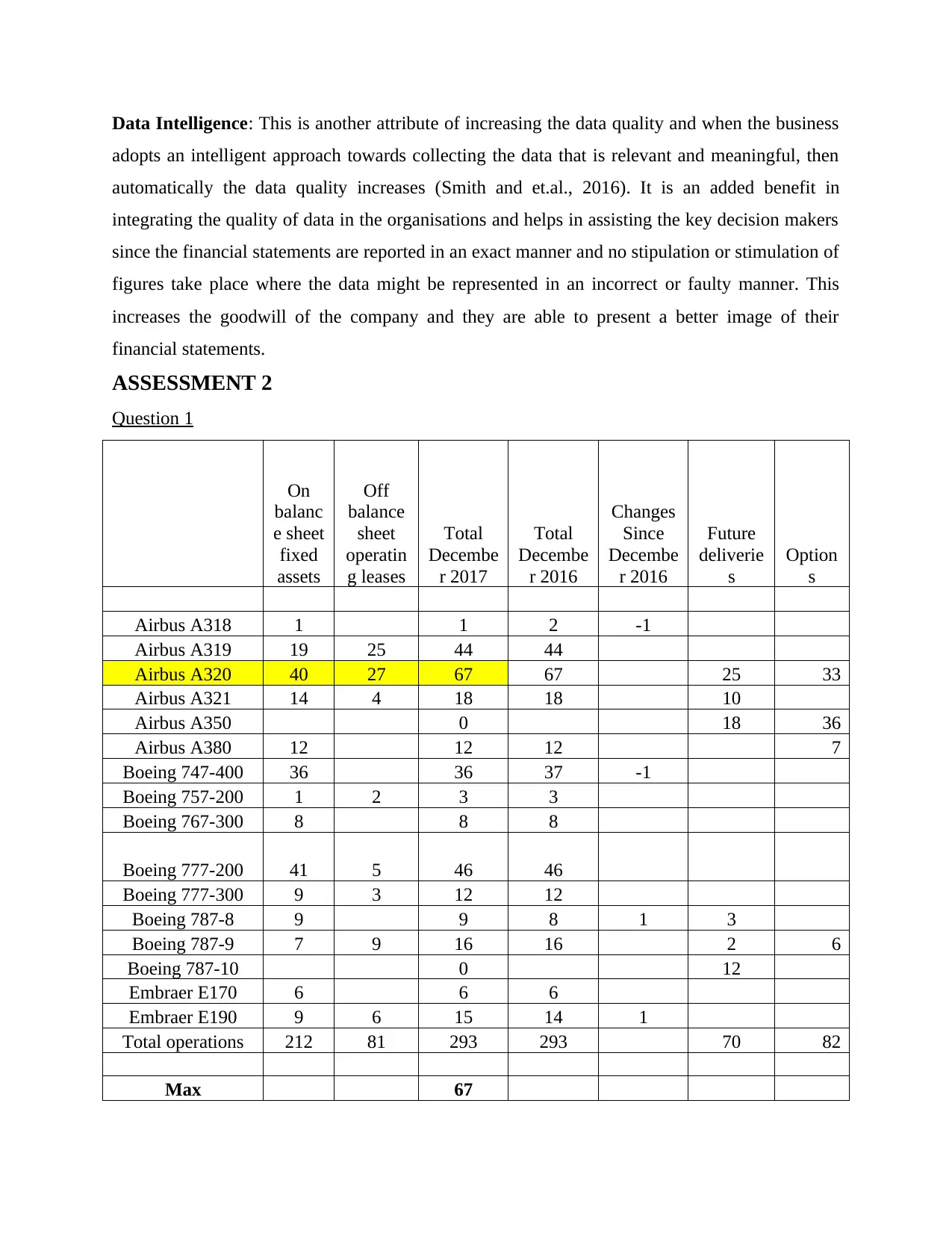
Data Intelligence: This is another attribute of increasing the data quality and when the business
adopts an intelligent approach towards collecting the data that is relevant and meaningful, then
automatically the data quality increases (Smith and et.al., 2016). It is an added benefit in
integrating the quality of data in the organisations and helps in assisting the key decision makers
since the financial statements are reported in an exact manner and no stipulation or stimulation of
figures take place where the data might be represented in an incorrect or faulty manner. This
increases the goodwill of the company and they are able to present a better image of their
financial statements.
ASSESSMENT 2
Question 1
On
balanc
e sheet
fixed
assets
Off
balance
sheet
operatin
g leases
Total
Decembe
r 2017
Total
Decembe
r 2016
Changes
Since
Decembe
r 2016
Future
deliverie
s
Option
s
Airbus A318 1 1 2 -1
Airbus A319 19 25 44 44
Airbus A320 40 27 67 67 25 33
Airbus A321 14 4 18 18 10
Airbus A350 0 18 36
Airbus A380 12 12 12 7
Boeing 747-400 36 36 37 -1
Boeing 757-200 1 2 3 3
Boeing 767-300 8 8 8
Boeing 777-200 41 5 46 46
Boeing 777-300 9 3 12 12
Boeing 787-8 9 9 8 1 3
Boeing 787-9 7 9 16 16 2 6
Boeing 787-10 0 12
Embraer E170 6 6 6
Embraer E190 9 6 15 14 1
Total operations 212 81 293 293 70 82
Max 67
adopts an intelligent approach towards collecting the data that is relevant and meaningful, then
automatically the data quality increases (Smith and et.al., 2016). It is an added benefit in
integrating the quality of data in the organisations and helps in assisting the key decision makers
since the financial statements are reported in an exact manner and no stipulation or stimulation of
figures take place where the data might be represented in an incorrect or faulty manner. This
increases the goodwill of the company and they are able to present a better image of their
financial statements.
ASSESSMENT 2
Question 1
On
balanc
e sheet
fixed
assets
Off
balance
sheet
operatin
g leases
Total
Decembe
r 2017
Total
Decembe
r 2016
Changes
Since
Decembe
r 2016
Future
deliverie
s
Option
s
Airbus A318 1 1 2 -1
Airbus A319 19 25 44 44
Airbus A320 40 27 67 67 25 33
Airbus A321 14 4 18 18 10
Airbus A350 0 18 36
Airbus A380 12 12 12 7
Boeing 747-400 36 36 37 -1
Boeing 757-200 1 2 3 3
Boeing 767-300 8 8 8
Boeing 777-200 41 5 46 46
Boeing 777-300 9 3 12 12
Boeing 787-8 9 9 8 1 3
Boeing 787-9 7 9 16 16 2 6
Boeing 787-10 0 12
Embraer E170 6 6 6
Embraer E190 9 6 15 14 1
Total operations 212 81 293 293 70 82
Max 67

Max in terms of
% 23%
a. Recognising the Aircraft type that has the largest fleet
From the above table, it has been reflected that the aircraft that contained a largest fleet
seems to be Airbus320 as compared to other type and competitive aircraft company. It resulted
as 67 which includes on balance sheet fixed assets and the off balance sheet operating leases.
b. Identifying an aircraft manufacturer from the data that is having a biggest representation in
British Airways
Airbus aircraft manufacturer contains the biggest representation in British Airways fleet
at the month of December 2017. This means that types of Airbus aircraft results higher
operations as compared to Boeing so it is called as the biggest representation manufacturer in
British Airways that acts as the Aircraft manufacturer.
c. Computing the percentage value of an entire total aircraft manufacturer
Airbus A320
67 / 293
= 23%
d. Producing the fully labelled chart reflecting the percentage of the 3 aircraft manufacturers in
terms of total fleet
No Aircraft type Total December 2017
1
Airbus A318 1
Airbus A319 44
Airbus A320 67
Airbus A321 18
Airbus A350 0
Airbus A380 12
Total 142
% of Airbus in against to total 48%
2
Boeing 747-400 36
Boeing 757-200 3
Boeing 767-300 8
Boeing 777-200 46
% 23%
a. Recognising the Aircraft type that has the largest fleet
From the above table, it has been reflected that the aircraft that contained a largest fleet
seems to be Airbus320 as compared to other type and competitive aircraft company. It resulted
as 67 which includes on balance sheet fixed assets and the off balance sheet operating leases.
b. Identifying an aircraft manufacturer from the data that is having a biggest representation in
British Airways
Airbus aircraft manufacturer contains the biggest representation in British Airways fleet
at the month of December 2017. This means that types of Airbus aircraft results higher
operations as compared to Boeing so it is called as the biggest representation manufacturer in
British Airways that acts as the Aircraft manufacturer.
c. Computing the percentage value of an entire total aircraft manufacturer
Airbus A320
67 / 293
= 23%
d. Producing the fully labelled chart reflecting the percentage of the 3 aircraft manufacturers in
terms of total fleet
No Aircraft type Total December 2017
1
Airbus A318 1
Airbus A319 44
Airbus A320 67
Airbus A321 18
Airbus A350 0
Airbus A380 12
Total 142
% of Airbus in against to total 48%
2
Boeing 747-400 36
Boeing 757-200 3
Boeing 767-300 8
Boeing 777-200 46
Paraphrase This Document
Need a fresh take? Get an instant paraphrase of this document with our AI Paraphraser
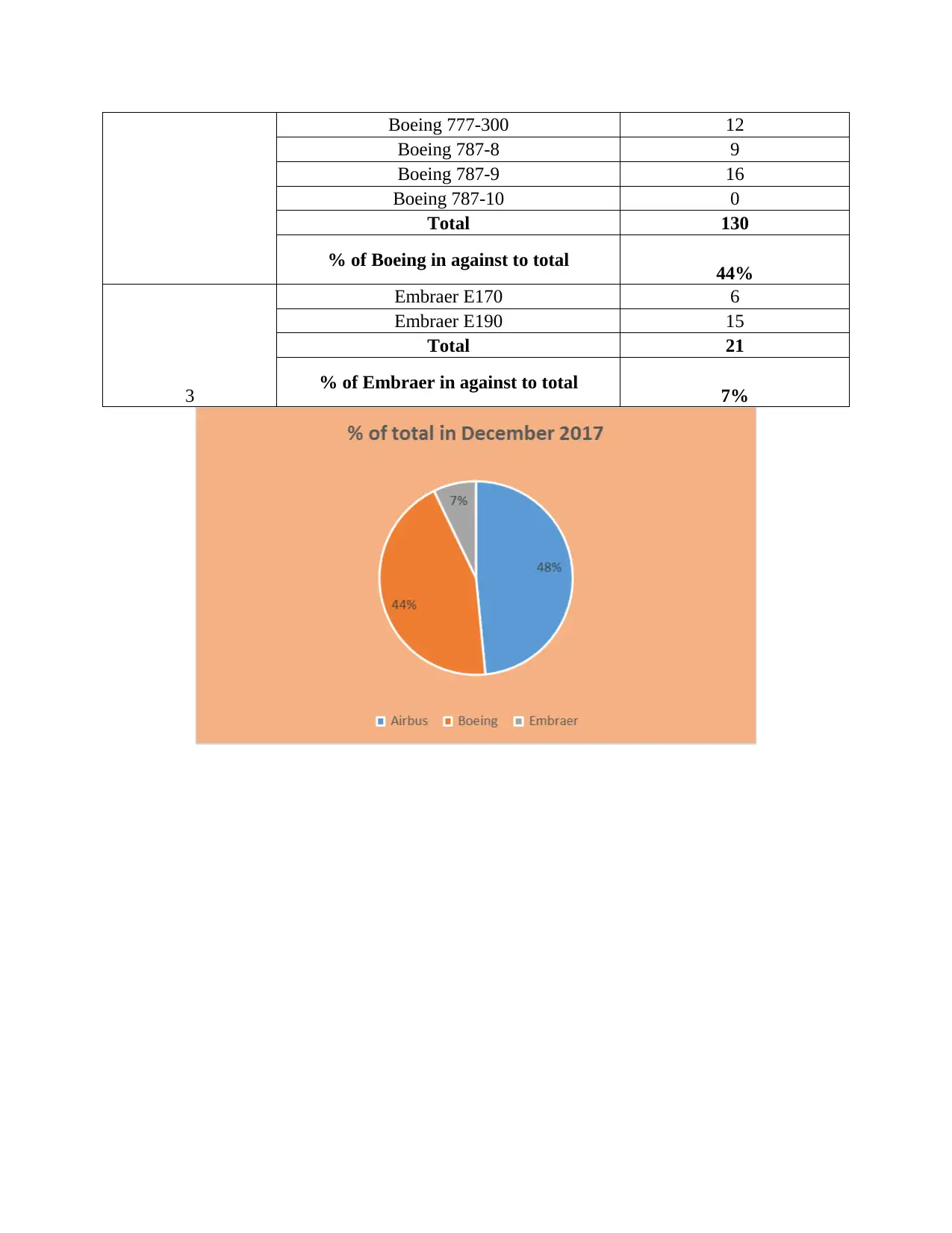
Boeing 777-300 12
Boeing 787-8 9
Boeing 787-9 16
Boeing 787-10 0
Total 130
% of Boeing in against to total 44%
3
Embraer E170 6
Embraer E190 15
Total 21
% of Embraer in against to total 7%
Boeing 787-8 9
Boeing 787-9 16
Boeing 787-10 0
Total 130
% of Boeing in against to total 44%
3
Embraer E170 6
Embraer E190 15
Total 21
% of Embraer in against to total 7%
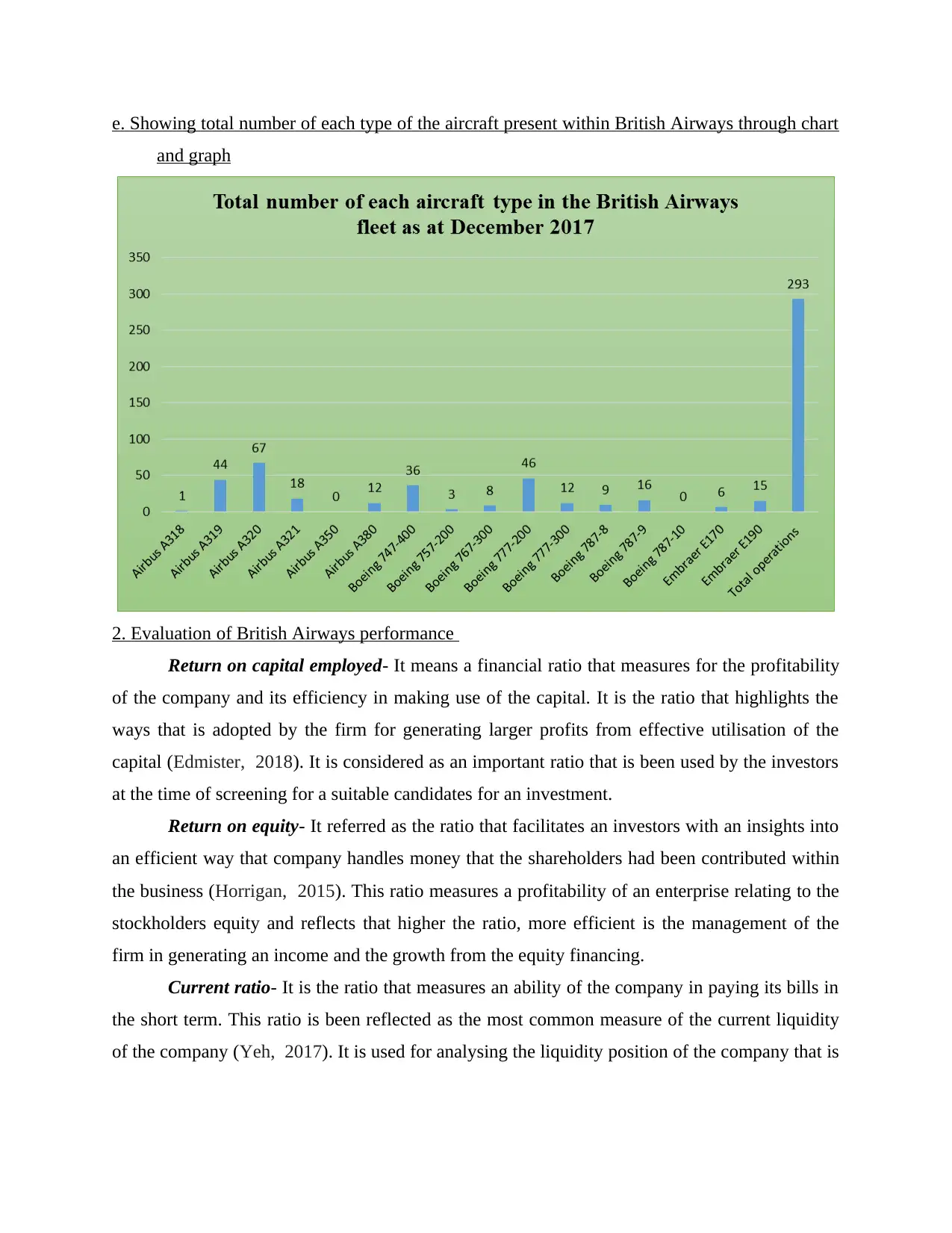
e. Showing total number of each type of the aircraft present within British Airways through chart
and graph
2. Evaluation of British Airways performance
Return on capital employed- It means a financial ratio that measures for the profitability
of the company and its efficiency in making use of the capital. It is the ratio that highlights the
ways that is adopted by the firm for generating larger profits from effective utilisation of the
capital (Edmister, 2018). It is considered as an important ratio that is been used by the investors
at the time of screening for a suitable candidates for an investment.
Return on equity- It referred as the ratio that facilitates an investors with an insights into
an efficient way that company handles money that the shareholders had been contributed within
the business (Horrigan, 2015). This ratio measures a profitability of an enterprise relating to the
stockholders equity and reflects that higher the ratio, more efficient is the management of the
firm in generating an income and the growth from the equity financing.
Current ratio- It is the ratio that measures an ability of the company in paying its bills in
the short term. This ratio is been reflected as the most common measure of the current liquidity
of the company (Yeh, 2017). It is used for analysing the liquidity position of the company that is
and graph
2. Evaluation of British Airways performance
Return on capital employed- It means a financial ratio that measures for the profitability
of the company and its efficiency in making use of the capital. It is the ratio that highlights the
ways that is adopted by the firm for generating larger profits from effective utilisation of the
capital (Edmister, 2018). It is considered as an important ratio that is been used by the investors
at the time of screening for a suitable candidates for an investment.
Return on equity- It referred as the ratio that facilitates an investors with an insights into
an efficient way that company handles money that the shareholders had been contributed within
the business (Horrigan, 2015). This ratio measures a profitability of an enterprise relating to the
stockholders equity and reflects that higher the ratio, more efficient is the management of the
firm in generating an income and the growth from the equity financing.
Current ratio- It is the ratio that measures an ability of the company in paying its bills in
the short term. This ratio is been reflected as the most common measure of the current liquidity
of the company (Yeh, 2017). It is used for analysing the liquidity position of the company that is
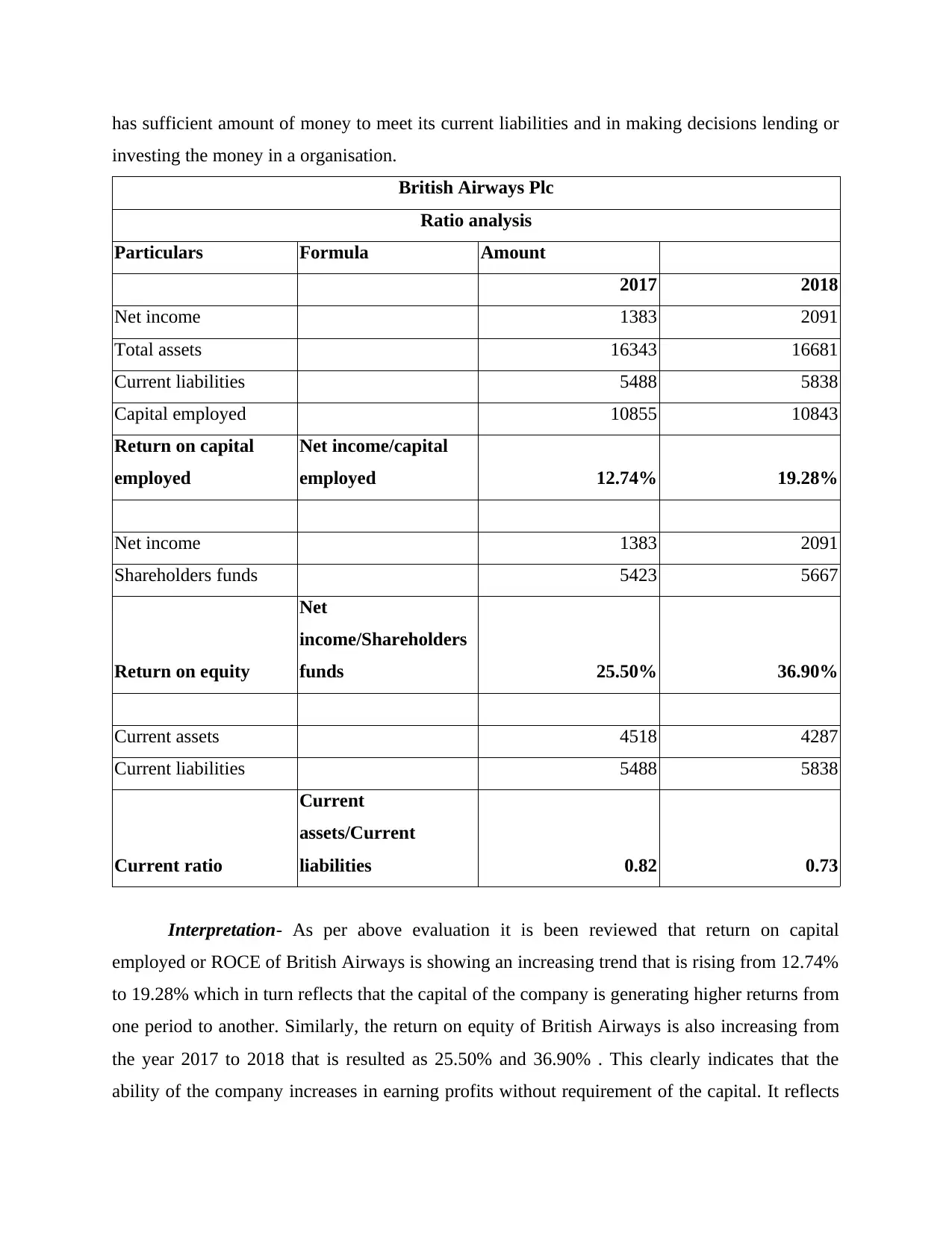
has sufficient amount of money to meet its current liabilities and in making decisions lending or
investing the money in a organisation.
British Airways Plc
Ratio analysis
Particulars Formula Amount
2017 2018
Net income 1383 2091
Total assets 16343 16681
Current liabilities 5488 5838
Capital employed 10855 10843
Return on capital
employed
Net income/capital
employed 12.74% 19.28%
Net income 1383 2091
Shareholders funds 5423 5667
Return on equity
Net
income/Shareholders
funds 25.50% 36.90%
Current assets 4518 4287
Current liabilities 5488 5838
Current ratio
Current
assets/Current
liabilities 0.82 0.73
Interpretation- As per above evaluation it is been reviewed that return on capital
employed or ROCE of British Airways is showing an increasing trend that is rising from 12.74%
to 19.28% which in turn reflects that the capital of the company is generating higher returns from
one period to another. Similarly, the return on equity of British Airways is also increasing from
the year 2017 to 2018 that is resulted as 25.50% and 36.90% . This clearly indicates that the
ability of the company increases in earning profits without requirement of the capital. It reflects
investing the money in a organisation.
British Airways Plc
Ratio analysis
Particulars Formula Amount
2017 2018
Net income 1383 2091
Total assets 16343 16681
Current liabilities 5488 5838
Capital employed 10855 10843
Return on capital
employed
Net income/capital
employed 12.74% 19.28%
Net income 1383 2091
Shareholders funds 5423 5667
Return on equity
Net
income/Shareholders
funds 25.50% 36.90%
Current assets 4518 4287
Current liabilities 5488 5838
Current ratio
Current
assets/Current
liabilities 0.82 0.73
Interpretation- As per above evaluation it is been reviewed that return on capital
employed or ROCE of British Airways is showing an increasing trend that is rising from 12.74%
to 19.28% which in turn reflects that the capital of the company is generating higher returns from
one period to another. Similarly, the return on equity of British Airways is also increasing from
the year 2017 to 2018 that is resulted as 25.50% and 36.90% . This clearly indicates that the
ability of the company increases in earning profits without requirement of the capital. It reflects
Secure Best Marks with AI Grader
Need help grading? Try our AI Grader for instant feedback on your assignments.
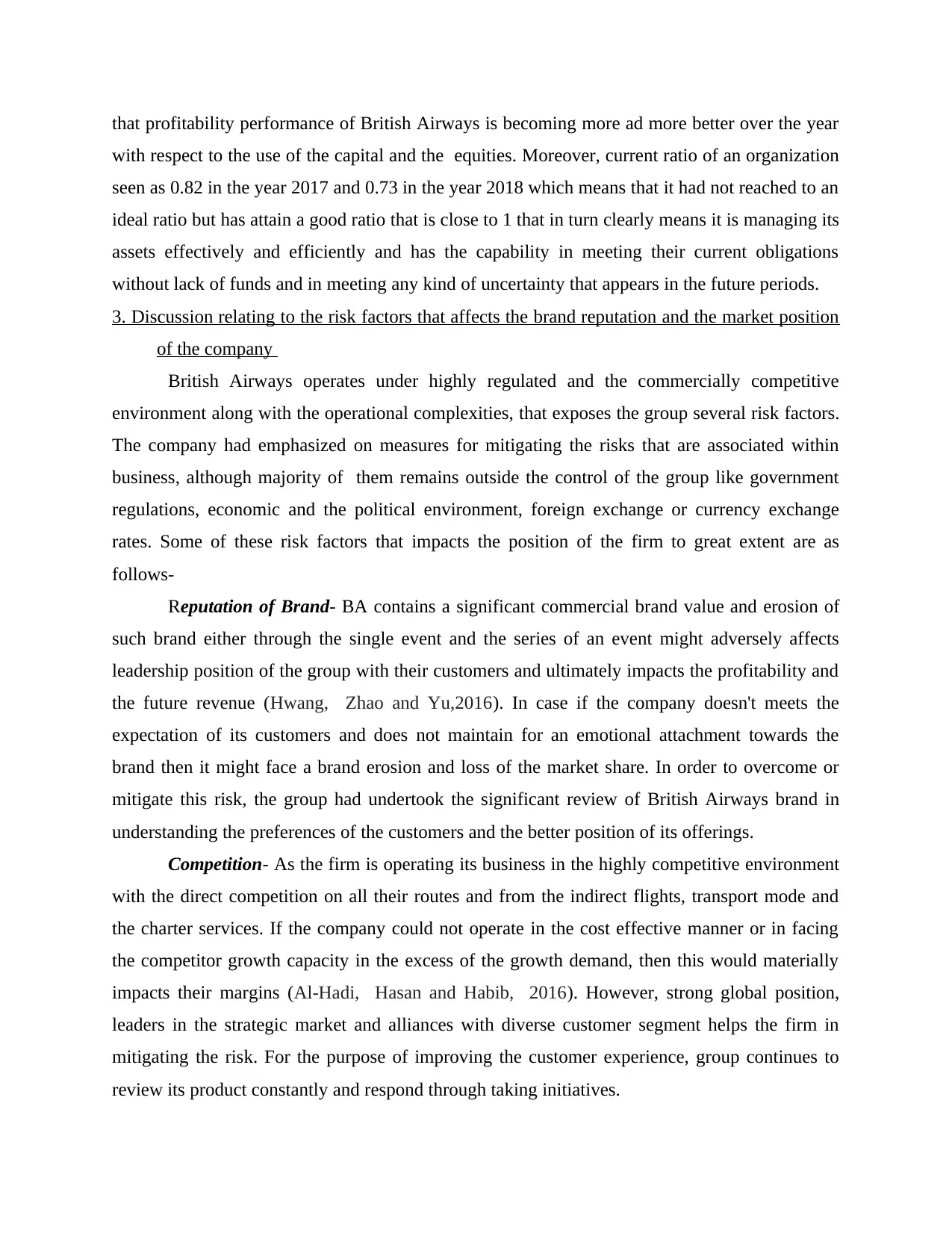
that profitability performance of British Airways is becoming more ad more better over the year
with respect to the use of the capital and the equities. Moreover, current ratio of an organization
seen as 0.82 in the year 2017 and 0.73 in the year 2018 which means that it had not reached to an
ideal ratio but has attain a good ratio that is close to 1 that in turn clearly means it is managing its
assets effectively and efficiently and has the capability in meeting their current obligations
without lack of funds and in meeting any kind of uncertainty that appears in the future periods.
3. Discussion relating to the risk factors that affects the brand reputation and the market position
of the company
British Airways operates under highly regulated and the commercially competitive
environment along with the operational complexities, that exposes the group several risk factors.
The company had emphasized on measures for mitigating the risks that are associated within
business, although majority of them remains outside the control of the group like government
regulations, economic and the political environment, foreign exchange or currency exchange
rates. Some of these risk factors that impacts the position of the firm to great extent are as
follows-
Reputation of Brand- BA contains a significant commercial brand value and erosion of
such brand either through the single event and the series of an event might adversely affects
leadership position of the group with their customers and ultimately impacts the profitability and
the future revenue (Hwang, Zhao and Yu,2016). In case if the company doesn't meets the
expectation of its customers and does not maintain for an emotional attachment towards the
brand then it might face a brand erosion and loss of the market share. In order to overcome or
mitigate this risk, the group had undertook the significant review of British Airways brand in
understanding the preferences of the customers and the better position of its offerings.
Competition- As the firm is operating its business in the highly competitive environment
with the direct competition on all their routes and from the indirect flights, transport mode and
the charter services. If the company could not operate in the cost effective manner or in facing
the competitor growth capacity in the excess of the growth demand, then this would materially
impacts their margins (Al‐Hadi, Hasan and Habib, 2016). However, strong global position,
leaders in the strategic market and alliances with diverse customer segment helps the firm in
mitigating the risk. For the purpose of improving the customer experience, group continues to
review its product constantly and respond through taking initiatives.
with respect to the use of the capital and the equities. Moreover, current ratio of an organization
seen as 0.82 in the year 2017 and 0.73 in the year 2018 which means that it had not reached to an
ideal ratio but has attain a good ratio that is close to 1 that in turn clearly means it is managing its
assets effectively and efficiently and has the capability in meeting their current obligations
without lack of funds and in meeting any kind of uncertainty that appears in the future periods.
3. Discussion relating to the risk factors that affects the brand reputation and the market position
of the company
British Airways operates under highly regulated and the commercially competitive
environment along with the operational complexities, that exposes the group several risk factors.
The company had emphasized on measures for mitigating the risks that are associated within
business, although majority of them remains outside the control of the group like government
regulations, economic and the political environment, foreign exchange or currency exchange
rates. Some of these risk factors that impacts the position of the firm to great extent are as
follows-
Reputation of Brand- BA contains a significant commercial brand value and erosion of
such brand either through the single event and the series of an event might adversely affects
leadership position of the group with their customers and ultimately impacts the profitability and
the future revenue (Hwang, Zhao and Yu,2016). In case if the company doesn't meets the
expectation of its customers and does not maintain for an emotional attachment towards the
brand then it might face a brand erosion and loss of the market share. In order to overcome or
mitigate this risk, the group had undertook the significant review of British Airways brand in
understanding the preferences of the customers and the better position of its offerings.
Competition- As the firm is operating its business in the highly competitive environment
with the direct competition on all their routes and from the indirect flights, transport mode and
the charter services. If the company could not operate in the cost effective manner or in facing
the competitor growth capacity in the excess of the growth demand, then this would materially
impacts their margins (Al‐Hadi, Hasan and Habib, 2016). However, strong global position,
leaders in the strategic market and alliances with diverse customer segment helps the firm in
mitigating the risk. For the purpose of improving the customer experience, group continues to
review its product constantly and respond through taking initiatives.
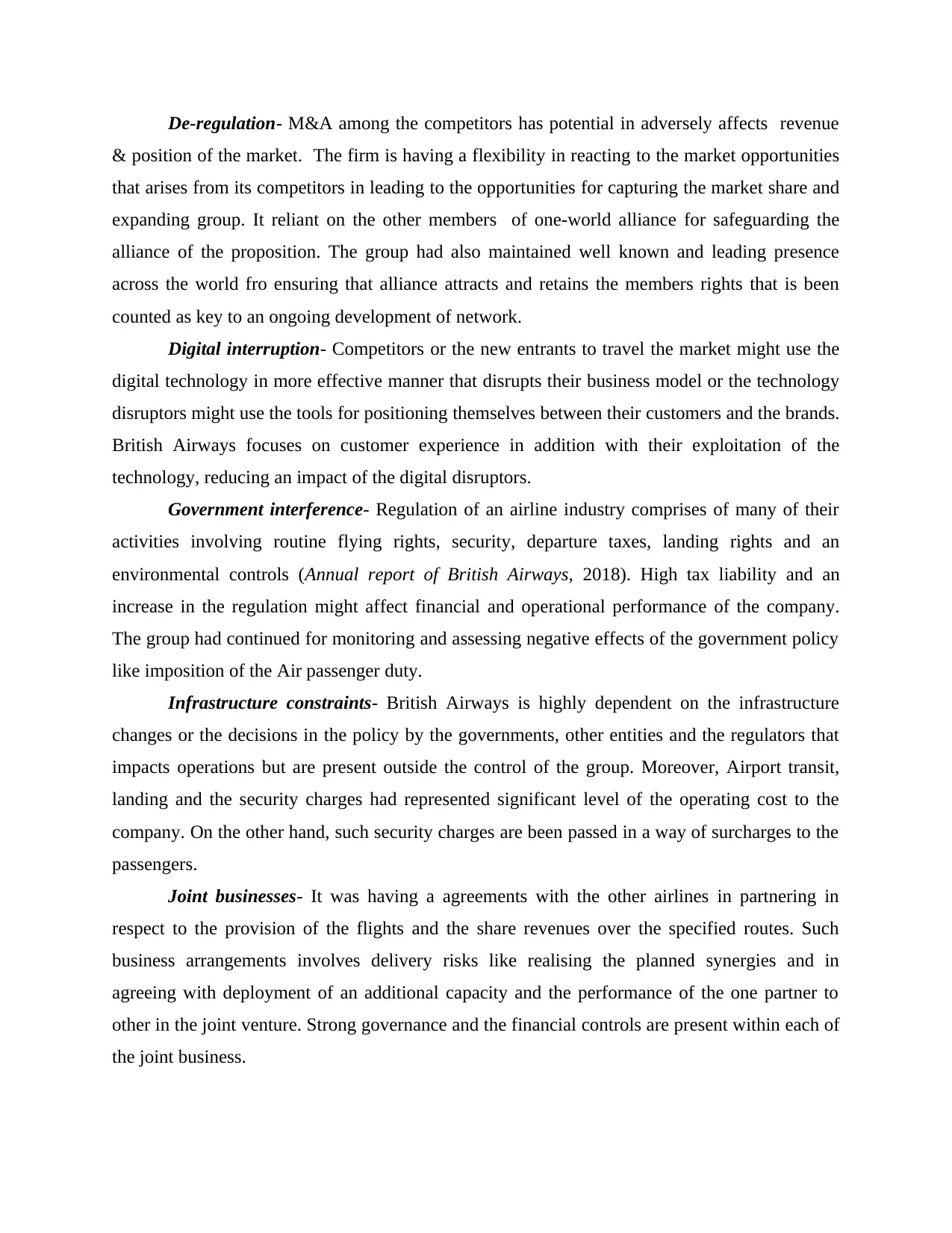
De-regulation- M&A among the competitors has potential in adversely affects revenue
& position of the market. The firm is having a flexibility in reacting to the market opportunities
that arises from its competitors in leading to the opportunities for capturing the market share and
expanding group. It reliant on the other members of one-world alliance for safeguarding the
alliance of the proposition. The group had also maintained well known and leading presence
across the world fro ensuring that alliance attracts and retains the members rights that is been
counted as key to an ongoing development of network.
Digital interruption- Competitors or the new entrants to travel the market might use the
digital technology in more effective manner that disrupts their business model or the technology
disruptors might use the tools for positioning themselves between their customers and the brands.
British Airways focuses on customer experience in addition with their exploitation of the
technology, reducing an impact of the digital disruptors.
Government interference- Regulation of an airline industry comprises of many of their
activities involving routine flying rights, security, departure taxes, landing rights and an
environmental controls (Annual report of British Airways, 2018). High tax liability and an
increase in the regulation might affect financial and operational performance of the company.
The group had continued for monitoring and assessing negative effects of the government policy
like imposition of the Air passenger duty.
Infrastructure constraints- British Airways is highly dependent on the infrastructure
changes or the decisions in the policy by the governments, other entities and the regulators that
impacts operations but are present outside the control of the group. Moreover, Airport transit,
landing and the security charges had represented significant level of the operating cost to the
company. On the other hand, such security charges are been passed in a way of surcharges to the
passengers.
Joint businesses- It was having a agreements with the other airlines in partnering in
respect to the provision of the flights and the share revenues over the specified routes. Such
business arrangements involves delivery risks like realising the planned synergies and in
agreeing with deployment of an additional capacity and the performance of the one partner to
other in the joint venture. Strong governance and the financial controls are present within each of
the joint business.
& position of the market. The firm is having a flexibility in reacting to the market opportunities
that arises from its competitors in leading to the opportunities for capturing the market share and
expanding group. It reliant on the other members of one-world alliance for safeguarding the
alliance of the proposition. The group had also maintained well known and leading presence
across the world fro ensuring that alliance attracts and retains the members rights that is been
counted as key to an ongoing development of network.
Digital interruption- Competitors or the new entrants to travel the market might use the
digital technology in more effective manner that disrupts their business model or the technology
disruptors might use the tools for positioning themselves between their customers and the brands.
British Airways focuses on customer experience in addition with their exploitation of the
technology, reducing an impact of the digital disruptors.
Government interference- Regulation of an airline industry comprises of many of their
activities involving routine flying rights, security, departure taxes, landing rights and an
environmental controls (Annual report of British Airways, 2018). High tax liability and an
increase in the regulation might affect financial and operational performance of the company.
The group had continued for monitoring and assessing negative effects of the government policy
like imposition of the Air passenger duty.
Infrastructure constraints- British Airways is highly dependent on the infrastructure
changes or the decisions in the policy by the governments, other entities and the regulators that
impacts operations but are present outside the control of the group. Moreover, Airport transit,
landing and the security charges had represented significant level of the operating cost to the
company. On the other hand, such security charges are been passed in a way of surcharges to the
passengers.
Joint businesses- It was having a agreements with the other airlines in partnering in
respect to the provision of the flights and the share revenues over the specified routes. Such
business arrangements involves delivery risks like realising the planned synergies and in
agreeing with deployment of an additional capacity and the performance of the one partner to
other in the joint venture. Strong governance and the financial controls are present within each of
the joint business.

4. Commenting on the revenue generated by the firm over the year from 2013 to 2017
Year British Airways Plc's worldwide revenue
2010 8537
2011 9987
2012 10827
2013 11421
2014 11719
2015 11333
2016 11398
2017 12226
Mean 10931
Standard deviation 1093
Interpretation- As per the results generated it has been evaluated that over the years
average value of revenue earned by British Airways resulted as 10931 and the standard deviation
that is dispersion from the average value accounted as 1093. from the year 2010 to 2013, the
revenue of the company is increasing which means that company had increased its market share
and created a larger customer base. This in turn indicates that the corporation is generating large
amount of profits over the years and leading towards high growth in terms of its revenue and
sales streams. It also reflects that an operational efficiency and the optimum use of the resources
has been made within the company which results to increase in the revenue over the years.
CONCLUSION
By summing up the above analysis it has been represented that British Airways is
performing well as it revenue and the profitability margins had increased over the years.
Moreover, it has also been indicated that financial analysis helps in depicting the liquidity,
profitability and an efficiency position of the company effectively.
Year British Airways Plc's worldwide revenue
2010 8537
2011 9987
2012 10827
2013 11421
2014 11719
2015 11333
2016 11398
2017 12226
Mean 10931
Standard deviation 1093
Interpretation- As per the results generated it has been evaluated that over the years
average value of revenue earned by British Airways resulted as 10931 and the standard deviation
that is dispersion from the average value accounted as 1093. from the year 2010 to 2013, the
revenue of the company is increasing which means that company had increased its market share
and created a larger customer base. This in turn indicates that the corporation is generating large
amount of profits over the years and leading towards high growth in terms of its revenue and
sales streams. It also reflects that an operational efficiency and the optimum use of the resources
has been made within the company which results to increase in the revenue over the years.
CONCLUSION
By summing up the above analysis it has been represented that British Airways is
performing well as it revenue and the profitability margins had increased over the years.
Moreover, it has also been indicated that financial analysis helps in depicting the liquidity,
profitability and an efficiency position of the company effectively.
Paraphrase This Document
Need a fresh take? Get an instant paraphrase of this document with our AI Paraphraser
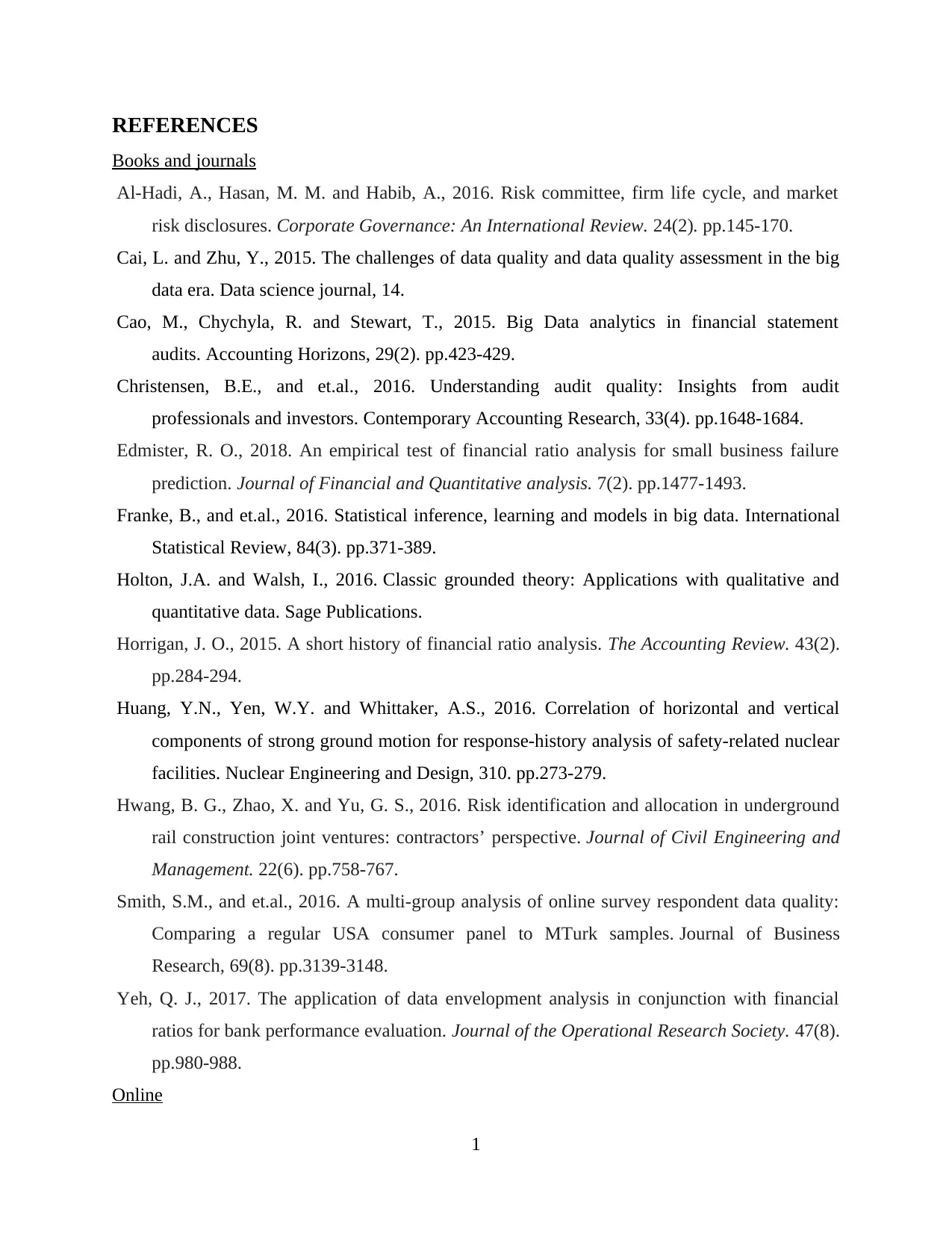
REFERENCES
Books and journals
Al‐Hadi, A., Hasan, M. M. and Habib, A., 2016. Risk committee, firm life cycle, and market
risk disclosures. Corporate Governance: An International Review. 24(2). pp.145-170.
Cai, L. and Zhu, Y., 2015. The challenges of data quality and data quality assessment in the big
data era. Data science journal, 14.
Cao, M., Chychyla, R. and Stewart, T., 2015. Big Data analytics in financial statement
audits. Accounting Horizons, 29(2). pp.423-429.
Christensen, B.E., and et.al., 2016. Understanding audit quality: Insights from audit
professionals and investors. Contemporary Accounting Research, 33(4). pp.1648-1684.
Edmister, R. O., 2018. An empirical test of financial ratio analysis for small business failure
prediction. Journal of Financial and Quantitative analysis. 7(2). pp.1477-1493.
Franke, B., and et.al., 2016. Statistical inference, learning and models in big data. International
Statistical Review, 84(3). pp.371-389.
Holton, J.A. and Walsh, I., 2016. Classic grounded theory: Applications with qualitative and
quantitative data. Sage Publications.
Horrigan, J. O., 2015. A short history of financial ratio analysis. The Accounting Review. 43(2).
pp.284-294.
Huang, Y.N., Yen, W.Y. and Whittaker, A.S., 2016. Correlation of horizontal and vertical
components of strong ground motion for response-history analysis of safety-related nuclear
facilities. Nuclear Engineering and Design, 310. pp.273-279.
Hwang, B. G., Zhao, X. and Yu, G. S., 2016. Risk identification and allocation in underground
rail construction joint ventures: contractors’ perspective. Journal of Civil Engineering and
Management. 22(6). pp.758-767.
Smith, S.M., and et.al., 2016. A multi-group analysis of online survey respondent data quality:
Comparing a regular USA consumer panel to MTurk samples. Journal of Business
Research, 69(8). pp.3139-3148.
Yeh, Q. J., 2017. The application of data envelopment analysis in conjunction with financial
ratios for bank performance evaluation. Journal of the Operational Research Society. 47(8).
pp.980-988.
Online
1
Books and journals
Al‐Hadi, A., Hasan, M. M. and Habib, A., 2016. Risk committee, firm life cycle, and market
risk disclosures. Corporate Governance: An International Review. 24(2). pp.145-170.
Cai, L. and Zhu, Y., 2015. The challenges of data quality and data quality assessment in the big
data era. Data science journal, 14.
Cao, M., Chychyla, R. and Stewart, T., 2015. Big Data analytics in financial statement
audits. Accounting Horizons, 29(2). pp.423-429.
Christensen, B.E., and et.al., 2016. Understanding audit quality: Insights from audit
professionals and investors. Contemporary Accounting Research, 33(4). pp.1648-1684.
Edmister, R. O., 2018. An empirical test of financial ratio analysis for small business failure
prediction. Journal of Financial and Quantitative analysis. 7(2). pp.1477-1493.
Franke, B., and et.al., 2016. Statistical inference, learning and models in big data. International
Statistical Review, 84(3). pp.371-389.
Holton, J.A. and Walsh, I., 2016. Classic grounded theory: Applications with qualitative and
quantitative data. Sage Publications.
Horrigan, J. O., 2015. A short history of financial ratio analysis. The Accounting Review. 43(2).
pp.284-294.
Huang, Y.N., Yen, W.Y. and Whittaker, A.S., 2016. Correlation of horizontal and vertical
components of strong ground motion for response-history analysis of safety-related nuclear
facilities. Nuclear Engineering and Design, 310. pp.273-279.
Hwang, B. G., Zhao, X. and Yu, G. S., 2016. Risk identification and allocation in underground
rail construction joint ventures: contractors’ perspective. Journal of Civil Engineering and
Management. 22(6). pp.758-767.
Smith, S.M., and et.al., 2016. A multi-group analysis of online survey respondent data quality:
Comparing a regular USA consumer panel to MTurk samples. Journal of Business
Research, 69(8). pp.3139-3148.
Yeh, Q. J., 2017. The application of data envelopment analysis in conjunction with financial
ratios for bank performance evaluation. Journal of the Operational Research Society. 47(8).
pp.980-988.
Online
1
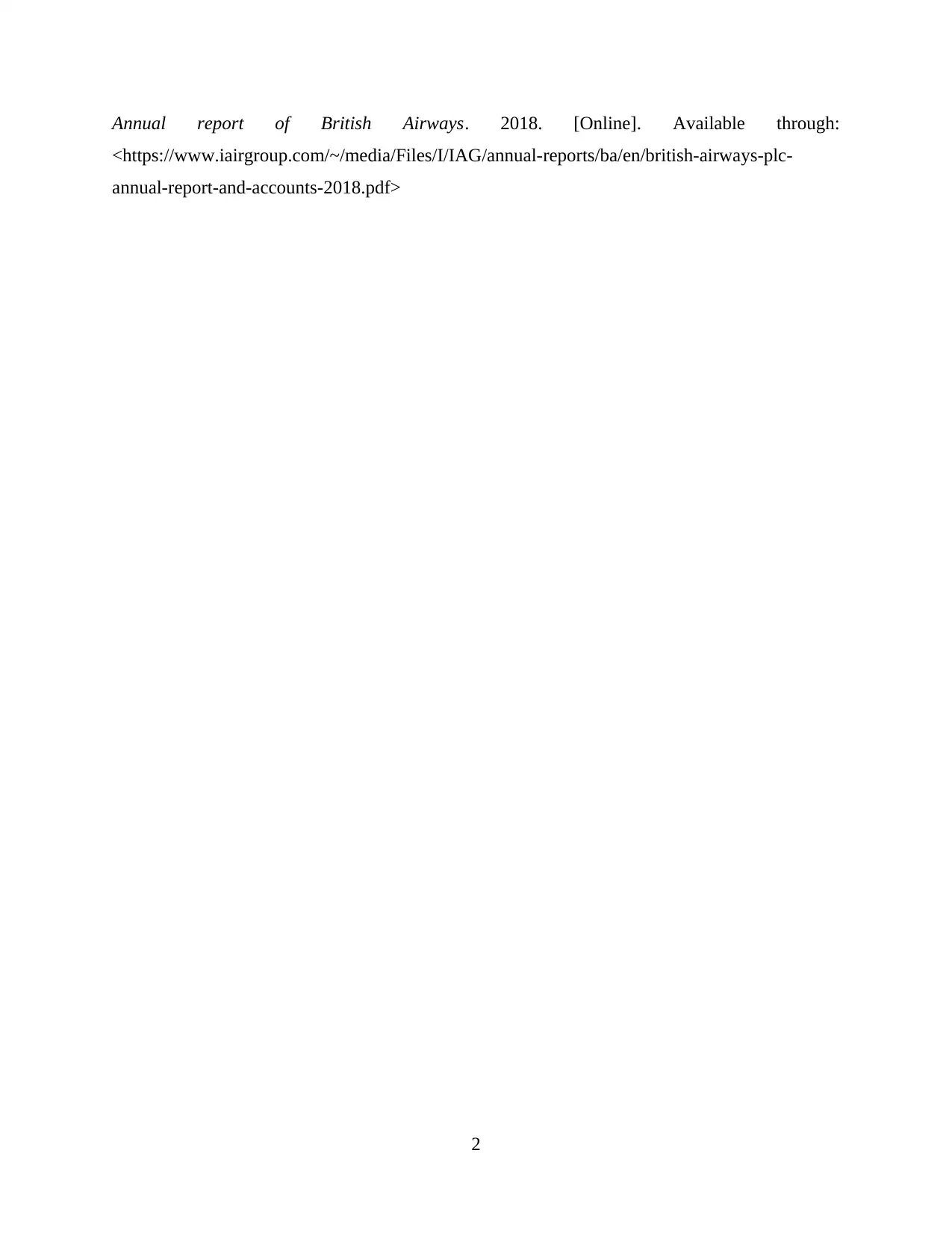
Annual report of British Airways. 2018. [Online]. Available through:
<https://www.iairgroup.com/~/media/Files/I/IAG/annual-reports/ba/en/british-airways-plc-
annual-report-and-accounts-2018.pdf>
2
<https://www.iairgroup.com/~/media/Files/I/IAG/annual-reports/ba/en/british-airways-plc-
annual-report-and-accounts-2018.pdf>
2
1 out of 15
Related Documents
Your All-in-One AI-Powered Toolkit for Academic Success.
+13062052269
info@desklib.com
Available 24*7 on WhatsApp / Email
![[object Object]](/_next/static/media/star-bottom.7253800d.svg)
Unlock your academic potential
© 2024 | Zucol Services PVT LTD | All rights reserved.





